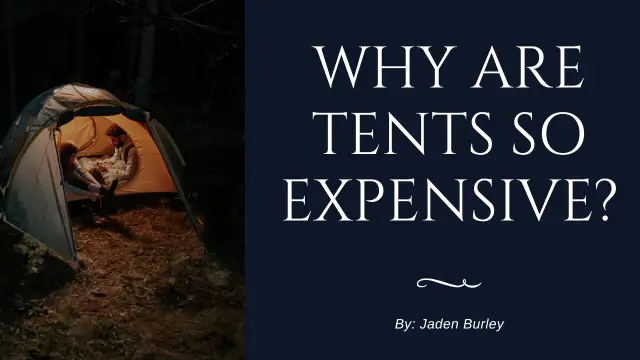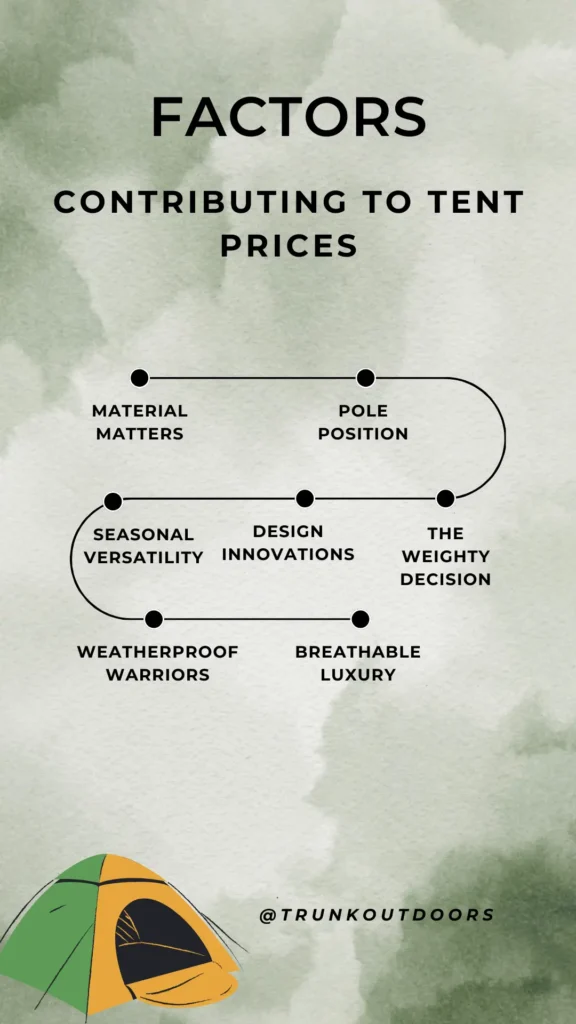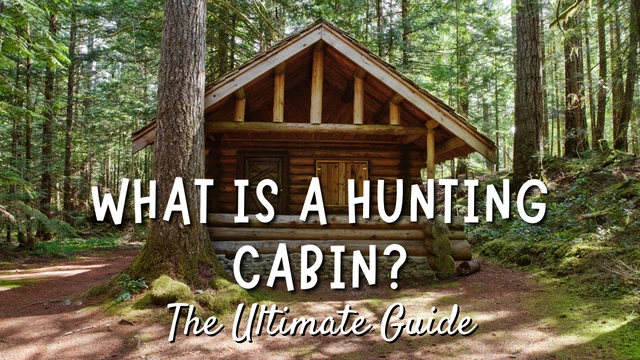Why Are Tents So Expensive?

If you’ve ever wondered why are tents so expensive and dent your wallet, you’re not alone. As a seasoned camper with over 12 years of camping, I’ve spent many nights in different tents, and the key is in the detailed construction.
In this detailed exploration:
- We dissect the factors contributing to the higher costs of tents. From material choices and innovative designs to the value of premium tents, we leave no tent peg unturned.
- Learn about the quality components, weatherproof features, and the long-term benefits of investing in a high-quality tent.
- Discover tips on saving money, buying and selling second-hand tents, and ensuring the longevity of your outdoor haven.
Understanding Tent Pricing
Getting a grip on tent prices is vital for both experienced campers and newcomers. If you like a rooftop escape or a light backpacking tent, knowing the typical cost range helps you make smart choices.
Why the Expensive Price? Factors Contributing to Tent Prices
Tents can be expensive because they are made with high-quality materials that are designed to withstand the elements. The size, features, and brand of a tent can also affect the price.

1. Material Matters
The materials used in a tent play a big role in its cost. Choosing top-notch fabrics with advanced weather-resistant tech naturally increases the price.
A tent with high-denier, ripstop nylon offers durability and weather resilience but comes at a higher cost than basic polyester.
2. Pole Position: Aluminum vs. Carbon Fiber
Tent pole material affects weight and cost. Lightweight aluminum or carbon fiber poles raise the price, but offer a balance of strength and portability.
Carbon fiber poles are the lightest, perfect for backpackers needing durability and weight savings.
3. The Weighty Decision
Backpacking tents cost more because they are made with lighter and stronger materials. These materials make the tent easier to carry, but they are also more expensive.
Ultralight tents are the lightest and most expensive type of backpacking tent. They are made with advanced materials like Dyneema, which is very strong and lightweight.
4. Design Innovations
Innovative design features, from quick-setup mechanisms to integrated accessories, add to a tent’s overall cost. These thoughtful additions enhance user experience but come at an expense.
Tents with airbeam technology for rapid inflation showcase how design innovations contribute to a higher price point.
5. Weatherproof Warriors
Tents engineered to withstand diverse weather conditions, be it heavy rain or snow, often employ advanced and costly materials. This commitment to weatherproofing influences the overall price.
Tents with silicone-coated rainflies exemplify the dedication to weather resistance, ensuring campers stay dry even in the harshest conditions.
6. Breathable Luxury
Enhanced breathability, a key consideration for comfort in various climates, may require specialized fabrics, contributing to a tent’s higher cost.
Tents with polycotton blends prioritize breathability without compromising durability, presenting a premium option.
7. Seasonal Versatility
All-season tents cost more because they are made to adapt to different seasons.
4-season tents are built to withstand winter conditions. Their versatile design and materials add to the cost.
The Value of Expensive Tents: A Closer Look
While premium tents carry a heftier price tag, their worth is often justified by various factors.
A. Quality Components
Expensive tents typically feature high-quality clips, sleeves, and grommets, ensuring durability and ease of use.
Tent clips and connectors made from robust materials enhance the tent’s structural integrity, justifying the investment.
B. Waterproof Assurance
Investing in a pricier tent often means superior waterproofing, providing reliable protection during rain or wet conditions.
Tents with taped seams and water-resistant zippers showcase how premium options keep campers dry in challenging weather.
C. Year-Round Reliability
Premium tents are made to withstand all kinds of weather, so you can use them year-round.
A 3-season tent with a convertible design can be changed to fit different climates, making it very versatile.
D. Featherlight Portability
Lightweight materials in expensive tents cater to backpackers and hikers, offering ease of portability without compromising durability.
Aluminum alloy poles in high-end tents exemplify how weight savings contribute to improved portability for outdoor enthusiasts.
E. Durability for the Long Haul
Expensive tents last longer because they use better materials and are built better.
For example: Cuben Fiber is a very strong and lightweight fabric that is often used in high-end tents.
Lifespan and Savings: Key Considerations
How Long Do Tents Last?
Understanding the lifespan of a tent hinges on factors such as quality, frequency of usage, and care. High-quality tents, if well-maintained, can last anywhere from 5-15 years, attesting to their enduring value.
How To Save Money on a Tent
For budget-conscious campers, saving money on a tent is possible with strategic approaches.
a. Hunt for Discounts
Explore discounts and promotions, especially during sales events or holiday seasons, to score significant cost savings.
b. Offseason Wisdom
Purchasing a tent offseason when demand is lower can lead to substantial cost savings as sellers aim to clear inventory.
c. Second-Hand Treasures
Buying a used tent can be a cost-effective option without compromising quality. Check online platforms and local marketplaces for second-hand deals.
d. Tent Rentals
For occasional campers, renting a tent can be an affordable alternative. However, for frequent campers, the cumulative cost might exceed the investment in purchasing a tent.
Selling Second-Hand Tents: Tips for Success
Selling a second-hand tent requires thoughtful steps to ensure a successful transaction.
1. Assess the Condition
Thoroughly assess the tent’s condition and provide accurate information to potential buyers. Honesty builds trust.
2. Visual Appeal
Capture high-quality photos showcasing the tent’s condition and features. Visual representation enhances marketability.
3. Detailed Seller Profile
Provide a detailed buyer profile, including your camping habits and the tent’s history. Transparency increases credibility.
4. Information is Key
Offer comprehensive information about the tent, including specifications and any modifications. Buyers appreciate detailed insights.
5. Strategic Marketing
Effectively market your tent through online platforms, local camping communities, and social media. A broad reach increases the likelihood of a sale.
Where To Buy/Sell Second-Hand Tents
Explore reputable platforms and communities for buying and selling second-hand tents. Online marketplaces, camping forums, and local classifieds are excellent avenues for transactions.
Tent TLC: How To Ensure Longevity
Maintaining your tent involves simple yet effective practices:
- Regular Cleaning: Remove dirt and debris regularly to keep your tent in top condition.
- Waterproofing Treatments: Apply waterproofing treatments as needed to maintain water resistance.
- Proper Storage: Store the tent properly, avoiding prolonged exposure to sunlight to prevent material degradation.
In conclusion, understanding tent costs involves knowing the crucial factors. Whether you go for a high-end or budget-friendly option, these insights help you navigate the diverse world of tent prices. Share your camping stories and questions in the comments, and keep those outdoor adventures coming!






